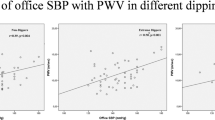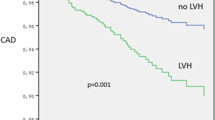Abstract
Dipping and nondipping blood pressure (BP) patterns are associated with different levels of target organ damage and cardiovascular risk. The aim of our investigation was to determine the relationship between different BP patterns (dipping, nondipping, extreme dipping and reverse dipping type) and cardiac structure, and function in hypertensive patients. This cross-sectional study included 376 hypertensive patients. All subjects underwent 24-h ambulatory BP monitoring, and complete two-dimensional, pulsed and tissue Doppler echocardiography. Most of the parameters of the left ventricular (LV) diastolic function (E/A, e′/a′, E/e′) significantly and progressively deteriorated from the extreme dippers to the dippers and nondippers, and finally to the reverse dippers. In contrast, LV structural parameters (IVS, RWT, LV mass index) showed a statistically important difference only by comparing the dippers and the extreme dippers with the rest of the patients. Simultaneously, the right ventricular (RV) structural parameter (RVT, right ventricular thickness), and most RV diastolic parameters significantly and progressively worsened from the extreme dippers, over the dippers and the nondippers, to the reverse dippers. Daytime and night time systolic BP, nocturnal systolic BP fall, and the nondipping and the reverse dipping status were independently associated with LV and RV structure, as well as with diastolic function. LV and RV structure, and diastolic function were significantly more impaired with the nondippers and the reverse dippers compared with others.
This is a preview of subscription content, access via your institution
Access options
Subscribe to this journal
Receive 12 digital issues and online access to articles
$119.00 per year
only $9.92 per issue
Buy this article
- Purchase on Springer Link
- Instant access to full article PDF
Prices may be subject to local taxes which are calculated during checkout
Similar content being viewed by others
References
O’Brien E, Sheridan J, O’Malley K . Dippers and non-dippers. Lancet 1988; 2: 397.
Ben-Dov IZ, Kark JD, Ben-Ishay D, Mekler J, Ben-Arie L, Bursztyn M . Predictors of all-cause mortality in clinical ambulatory monitoring: unique aspects of blood pressure during sleep. Hypertension 2007; 49: 1235–1241.
Cuspidi C, Meani S, Valerio C, Negri F, Sala C, Maisaidi M et al. Body mass index, nocturnal fall in blood pressure and organ damage in untreated essential hypertensive patients. Blood Press Monit 2008; 13: 318–324.
García-Ortiz L, Gómez-Marcos MA, Martín-Moreiras J, González-Elena LJ, Recio-Rodriguez JI, Castaòo-Sánchez Y et al. Pulse pressure and nocturnal fall in blood pressure are predictors of vascular, cardiac and renal target organ damage in hypertensive patients (LOD-RISK study). Blood Press Monit 2009; 14: 145–151.
Cuspidi C, Michev I, Meani S, Valerio C, Bertazzoli G, Magrini F et al. Non-dipper treated hypertensive patients do not have increased cardiac structural alterations. Cardiovasc Ultrasound 2003; 1: 1.
Grandi AM, Broggi R, Jessula A, Laurita E, Cassinerio E, Piperno F et al. Relation of extent of nocturnal blood pressure decrease to cardiovascular remodeling in never-treated patients with essential hypertension. Am J Cardiol 2002; 89: 1193–1196.
Grassi G, Seravalle G, Quarti-Trevano F, Dell’Oro R, Bombelli M, Cuspidi C et al. Adrenergic, metabolic, and reflex abnormalities in reverse and extreme dipper hypertensives. Hypertension 2008; 52 (5): 925–931.
Muxfeldt ES, Cardoso CR, Salles GF . Prognostic value of nocturnal blood pressure reduction in resistant hypertension. Arch Intern Med 2009; 169 (9): 874–880.
Schiller NB, Shah PM, Crawford M, DeMaria A, Devereux R, Feigenbaum H et al. Recommendations for quantitation of the left ventricle by two-dimensional echocardiography. American Society of Echocardiography committee on standards, subcommittee on quantitation of two-dimensional echocardiograms. J Am Soc Echocardiogr 1989; 2: 358–367.
Devereux RB, Reichek N . Echocardiographic determination of left ventricular mass in man. Anatomic validation of the method. Circulation 1977; 55: 613–618.
Quinones MA, Otto CM, Stoddard M, Waggoner A, Zoghbi WA . Recommendations for quantification of Doppler echocardiography: a report from the Doppler quantification task force of the nomenclature and standards committee of the American Society of Echocardiography. J Am Soc Echocardiogr 2002; 15: 167–184.
Sherif N, Appleton C, Gillebert T, Marino P, Oh J, Smiseth O et al. Recommendations for the evaluation of left ventricular diastolic function by echocardiography. Eur J Echocardio 2009; 10: 165–193.
Tei C, Ling LH, Hodge DO, Bailey KR, Oh JK, Rodeheffer RJ et al. New index of combined systolic and diastolic myocardial performance: a simple and reproducible measure of cardiac function-a study in normals and dilated cardiomyopathy. J Cardiol 1995; 26: 357–366.
Rudski LG, Lai WW, Afilalo J, Hua L, Handschumacher MD, Chandrasekaran K et al. Guidelines for the echocardiographic assessment of the right heart in adults: a report from the American Society of Echocardiography endorsed by the European Association of Echocardiography, a registered branch of the European Society of Cardiology, and the Canadian Society of Echocardiography. J Am Soc Echocardiogr 2010; 23 (7): 685–713.
Cuspidi C, Valerio C, Sala C, Negri F, Esposito A, Masaidi M et al. Metabolic syndrome and biventricular hypertrophy in essential hypertension. J Hum Hypertens 2009; 23 (3): 168–175.
Cuspidi C, Meani S, Salerno M, Valerio C, Fusi V, Severgnini B et al. Cardiovascular target organ damage in essential hypertensives with or without reproducible nocturnal fall in blood pressure. J Hypertens 2004; 22: 273–280.
Cuspidi C, Macca G, Sampieri L, Fusi V, Severgnini B, Michev I et al. Target organ damage and non-dipping pattern defined by two sessions of ambulatory blood pressure monitoring in recently diagnosed essential hypertensive patients. J Hypertens 2001; 19: 1539–1545.
Ferrara AL, Pasanisi F, Crivaro M, Guida L, Palmieri V, Gaeta I et al. Cardiovascular abnormalities in never-treated hypertensives according to nondipper status. Am J Hypertens 1998; 11: 1352–1357.
Roman MJ, Pickering TG, Schwartz JE, Cavallini MC, Pini R, Devereux RB . Is the absence of a normal nocturnal fall in blood pressure (nondipping) associated with cardiovascular target organ damage? J Hypertens 1997; 15 (9): 969–978.
Cuspidi C, Michev I, Meani S, Severgnini B, Fusi V, Corti C et al. Reduced nocturnal fall in blood pressure, assessed by two ambulatory blood pressure monitorings and cardiac alterations in early phases of untreated essential hypertension. J Hum Hypertens 2003; 17 (4): 245–251.
Cuspidi C, Meani S, Negri F, Valerio C, Sala C, Mancia G . Is blunted heart rate decrease at night associated with prevalent organ damage in essential hypertension? Blood Press Monit 2011; 16 (1): 16–21.
Seo HS, Kang TS, Park S, Choi EY, Ko YG, Choi D et al. Non-dippers are associated with adverse cardiac remodelling and dysfunction. Int J Cardiol 2006; 112: 171–177.
Sokmen G, Sokmen A, Aksu E, Koroglu S, Suner A, Tuncer C . The influence of ambulatory blood pressure profile on global and regional functions of the left and the right ventricles in orderly treated hypertensive patients. Echocardiography 2008; 25 (5): 465–472.
Tigen K, Karaahmet T, Fotbolcu H, Gürel E, Cevik C, Geçmen C et al. The influence of dipper and nondipper blood pressure patterns on left ventricular functions in hypertensive patients: a tissue Doppler study. Turk Kardiyol Dern Ars 2009; 37 (2): 101–106.
Vyssoulis GP, Karpanou EA, Kyvelou SM, Adamopoulos DN, Deligeorgis AD, Spanos PG et al. Nocturnal blood pressure fall and metabolic syndrome score in hypertensive patients. Blood Press Monit 2007; 12: 351–356.
Grassi G . Renin-angiotensin-sympathetic crosstalks in hypertension: reappraising the relevance of peripheral interactions. J Hypertens 2001; 19 (10): 1713–1716.
Syrseloudis D, Tsioufis C, Aragiannis D, Soulis D, Stefanadi E, Spanos A et al. The dominant role of the systolic component of nondipping status on target-organ damage in never-treated hypertensives. Am J Hypertens 2011; 24 (3): 292–298.
Author information
Authors and Affiliations
Corresponding author
Ethics declarations
Competing interests
The authors declare no conflict of interest.
Rights and permissions
About this article
Cite this article
Ivanovic, B., Tadic, M. & Celic, V. To dip or not to dip? The unique relationship between different blood pressure patterns and cardiac function and structure. J Hum Hypertens 27, 62–70 (2013). https://doi.org/10.1038/jhh.2011.83
Received:
Revised:
Accepted:
Published:
Issue Date:
DOI: https://doi.org/10.1038/jhh.2011.83
Keywords
This article is cited by
-
Association between non-dipping blood pressure pattern and different glucometabolic profile during oral glucose tolerance test
Internal and Emergency Medicine (2024)
-
Is there any true distinction in extreme dipping versus nondipping or dipping phenotype regarding hypertension-mediated organ damage in newly diagnosed and never-treated hypertensive patients?
Journal of Human Hypertension (2022)
-
Extreme dipping and target organ damage: is there any relationship?
Journal of Human Hypertension (2021)
-
Characteristics of Circadian Blood Pressure Pattern of Hypertensive Patients According to Localization of Fragmented QRS on Electrocardiography
High Blood Pressure & Cardiovascular Prevention (2021)
-
Do reverse dippers have the highest risk of right ventricular remodeling?
Hypertension Research (2020)



